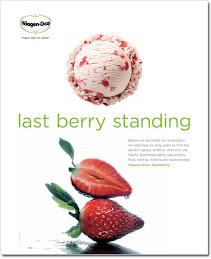Recently I have wondered how companies with an environmental focus can effectively differentiate themselves given the increasing numbers of products marketed as “green” and “eco-friendly.” For some products, it seems like an effective marketing strategy could be to choose a value proposition that is closely aligned with customers’ desire for a greener world, yet distinct from it. So many companies for very good reasons choose one of a few terms to describe their environmentally friendly products. Words like “green,” “sustainable,” and “natural,” are loaded with meaning and permeate the market. Because consumers hear these terms applied to so many different products, they have become confused and skeptical. In addition, though many consumers claim a desire for earth-friendly products, other product attributes, including price, quality, and product experience, also drive purchase decisions.
Recently, J. Tyler Johnson, former Chief Marketing Officer of Dryer’s Ice Cream, spoke to my consumer behavior class. After apologizing for coming to campus without samples, he largely discussed the re-launch of the Haagen-Dazs brand. One thing that struck me was how well-aligned H-D’s new brand positioning is with green values, though the brand never uses the words I mentioned above. And, indeed, the intent of management was never to position the brand as eco-friendly. Mr. Johnson briefly mentioned the fact that though H-D ice cream is all natural, its competitor, Ben & Jerry’s had already positioned itself as the socially and environmentally ice cream alternative. Thus, touting the “all-natural” component would not differentiate H-D in the eyes of consumers, and H-D executives searched for a value proposition that would.
How did Haagen-Dazs choose their branding? Market research showed that the H-D brand was viewed as slightly snobby and inaccessible by many consumers. H-D wanted a message that would allow the brand to escape from such negative perceptions. What else did research reveal? Consumers of the premium ice cream segment, those small pints you find in the store, were looking for an ice cream to provide them their moment of indulgence and escape. Based on such insights, H-D and its vendors formulated an incredible advertising campaign. H-D chose to reposition their brand as the simple, pure ice cream alternative. They focused on the quality of ingredients with the tag line, “Made Like No Other.” Later commercials emphasized the indulgent nature of their pure ingredients. How did the Made Like No Other campaign work out for Haagen-Dazs? Mr. Johnson and his team grew a brand previously targeted to just 1.5% of American households into the market leader in its category.
One of the reasons I am so intrigued by this marketing success story is that I can envision the same customer who drives a Prius, shops for organic produce, and uses bio-degradable cleaners, buying H-D ice cream and savoring it at night. The words “simple” and “pure” convey so many positive images, and they have many environmental undertones. I believe an intentional use of terms like these which are aligned with green values could be very effective for some brands.
Check out the H-D re-launch campaign commercial on YouTube:
http://www.youtube.com/watch?v=GEpenoD9-Ts
Later advertisements added indulgence to the value proposition:
http://www.youtube.com/watch?v=VQP0GGjhoOM&NR=1
Subscribe to:
Post Comments (Atom)








No comments:
Post a Comment